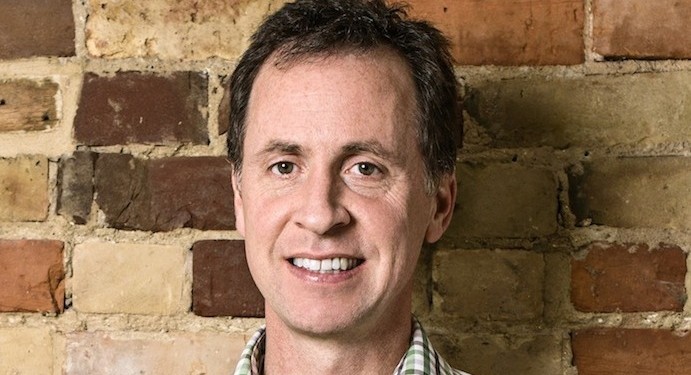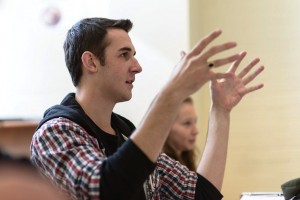CH: We send over 1,000 students a year. We do both our summer programmes and also we do community service programmes as well. I would say community service is a sub-programme of international summers. The students don’t earn a high school credit but they get their community hours which is a requirement of studying at a high school in Canada. We do those in Asia and Latin America.
News and business analysis for Professionals in International Education
Have some pie!
Cam Harvey, Blyth Education, Canada

The PIE: And what about the size of the high schools you operate?
CH: Each school varies in size – anywhere from 60 – 175 students. We currently have almost 600 students across all the campuses and we’re aiming for about 900 next year. We’d like to recruit about 100 international students to all our campuses combined. We currently have just a handful, 20 or so students. We think that what we’ve got here is pretty special and we’re going to open it up to a select group of agents and students.
The PIE: And how many of the international students you are likely to recruit will be keen to stay on and go on to university in Canada?
“We’d like to recruit about 100 international students to all our campuses combined”
CH: A lot of students that are coming from Asia, are looking to get their secondary school diploma and then go on to university. For the other markets I think, Latin America and Europe, it’s more for the experience, they are mainly coming for a semester or they are coming for an academic year and in some cases they are validating their courses and they are getting credit for it back home but they are not looking for the high school diploma.
The PIE: That’s an interesting question actually, how many of the international students are you expecting to just stay for one semester or one year as opposed to five years, six years, you know the whole time?
CH: I would say about a third stay on, so we would see Chinese, Korea, perhaps Japanese students that would come for a minimum two years. But in some cases it will be upwards of four or five years because we do have elementary school programmes as well that are available to students as young as 11 or 12 years old.
The PIE: Why has Blyth decided to look outwards and become more international in focus?
CH: For all the well-understood reasons: any student, no matter where they’re studying, is always going to benefit from international perspectives from other students. And up until recently this is simply a market that we haven’t had the opportunity to grow. But we’re certainly focussing on it now.
“Many schools have got so many international students that is is becoming less interesting for internationals to attend”
Because we haven’t focused our efforts internationally until now, we’ve ended up with something that is very attractive, which is that we are largely a Canadian student school, and that’s something that a lot of high schools can’t say anymore; many schools have got so many international students that it is becoming less interesting for internationals to attend those schools.
The PIE: Do you see more education agencies taking an interest in the high school sector now?
CH: Yes, absolutely. It depends on the market but I think you’re seeing parents that are saying “well, I want more of a foundation type of experience for my kids”, and so high school is sort of the natural answer for that. The younger you get students in a programme, the more bi-cultural they’ll be, the better English they are obviously going to have and also the more choices they will have for college or university.
The PIE: It looks like you’ve got some really interesting overseas programmes, I see one in Bhutan. Which one would you most like to do if you had your time again?
CH: (Laughs) It’s interesting, when we talk to Canadian parents and we’re doing these presentations, the parents’ heads are spinning and they say “my whole experience of high school would have changed if I had been on one of these programmes”. I think the one that just jumps out for me is the Amazon and Galapagos. That’s our goal for students – to make academic course content relevant, real, and engaging.
My understanding and experience of what science could have been as a high school student would have been completely turned on its head if I had the opportunity to go and study biology in the Amazon rainforest or on the Galapagos Islands.
The PIE: What sort of price tag does that have?
CH: It varies, the programmes are four weeks long and we’ve got programmes that are as cheap as a little under CAN$3,000 in Cozumel or CAN$4,000 in Costa Rica. These are package programmes: it includes the flight in and out of Toronto, all the meals and accomodation, the instruction, the credit, everything. Though this is also available without the flight.
And then we have programmes that are in Australia, Fiji or New Zealand, so we do snorkeling in Australia and biology and photography in Australia and we do heli-skiing in New Zealand and those are upwards of CAN$8,000 or CAN$9,000. So, it’s a real range of prices.
Still looking? Find by category:




I want to be part in your prestigious school in Canada.
Thanks for your note! Please email us directly at admissions@blytheducation.com or call at +1 416 960 3552. Look forward to speaking with you.
Hello Cam Harvey.
My name is Yukio Morikawa,KANZEI high school,Okayama. Do you remember me? Please send me your mail. I’m looking forward to your mail.
Yukio Morikawa Okayama Japan